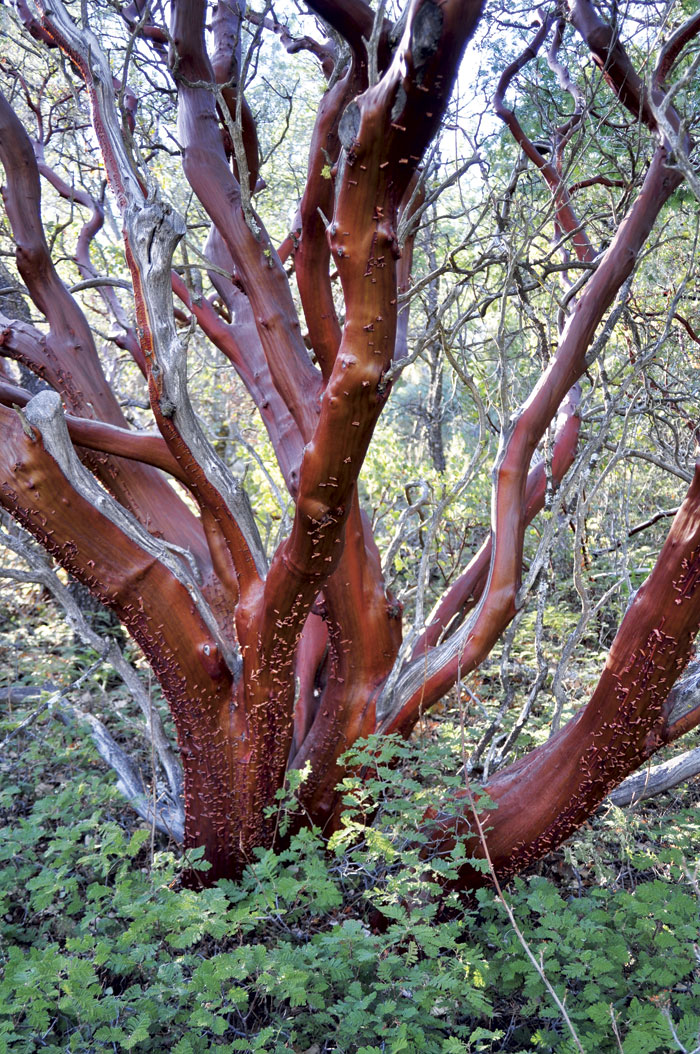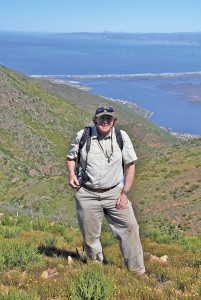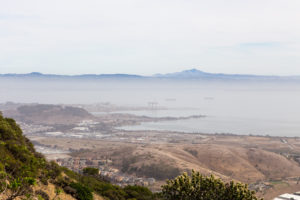California doesn’t have an official state shrub (Texas has two!), but our state’s iconic manzanitas—the shiny red-barked shrubs found in chaparral and many other habitats—seem like a shoo-in for the honor. And no one knows these beautiful plants better than Mike Vasey, who along with co-authors Tom Parker and Michael Kauffmann has produced a book that will help acquaint the rest of us with this fascinating group: A Field Guide to Manzanitas: California, North America, and Mexico (Backcountry Press, 2015). Vasey and Parker have been studying the genus Arctostaphylos for 25 years, traveling up and down the state and into Baja to document the 104 known species and subspecies in California and Mexico. But Vasey’s interest in the natural world doesn’t end with manzanitas. He is also the director of the San Francisco Bay National Estuarine Research Reserve, which promotes the understanding and protection of valuable coastal wetlands. And for his Ph.D., which he recently completed at UC Santa Cruz, he researched the influence of the summer marine layer (i.e., fog) on chaparral along the central coast of California. His infectious enthusiasm for all of these topics and more is inescapable.
Sue Rosenthal: How did you first become interested in natural history and plants?
Mike Vasey: I was living in Marin County in the 1970s and hiking a lot. I had a camera with a nice macro lens, and I gravitated to flowers, plants, and landscapes. I began to wonder what I was taking pictures of, so I joined the native plant society and took a couple of classes at the College of Marin and really got fired up.
I think the seminal event was a talk by [evolutionary biologist] Ledyard Stebbins on the five Mediterranean-type climate regions in the world. I became completely enamored with evolutionary ecology, and I realized that this was something I really wanted to study. I was working in a totally different field at the time, but I was getting more and more into natural history, so I went to San Francisco State to do my master’s while still working part-time.
But I wasn’t studying manzanitas; I was working on a rare flower, bird rock goldfields, Lasthenia maritima [which only grow on sea stacks]. What really interested me was the question, What makes species rare? There are all kinds of ways for species to become rare. They can start out rare, or they can contract and become rare over time because of changing conditions and so on—the newly evolved versus relict species. So I decided I wanted to do my research on that question.
And one of the species that interested me right off the bat was the bird rock goldfields, which [botanist] Robert Ornduff considered a newly evolved species. I was driving across the Golden Gate Bridge one day, and I saw the Farallones out there, and I said, “Yeah, I know they’re out there; I want to look into that.” It took me quite a bit just to get permission to go out there, and by then I was really getting into it and I realized I didn’t need to do anything else; it was more than enough for a thesis.
I spent a fair amount of time out on the Farallones and going up and down the coast, climbing bird rocks. I eventually got this 13-foot Boston Whaler with rails on the front. I would go out with somebody and stand outboard of the rails while they brought me in on the lee side of the rock, and I would jump off and climb the rock. It was the adventure of a lifetime! I don’t think I’ll ever do it again. And probably nobody would let me do it again because of the birds that nest out there. But it was an amazing experience.
SR: And how did you become interested in manzanitas?
MV: As I said, local rarity was my big focus. And during the 1980s, I spent a lot of time in the field with Stebbins. He was one of these guys—for him, going on a plant expedition was like fishing. If he didn’t find a new species, or a new variety, or a new locality, he was really unhappy. He felt like he’d been shut out. So I got this chance to go with him to all these amazing places looking for rare plants. But when I chose the goldfields for my thesis, I kind of left the other ones I had been thinking about, which were some locally rare manzanitas.
Then, in 1991, just after I’d started teaching at San Francisco State, I went down to Rancho Santa Ana Botanic Garden and met Nancy Morin, editor of Flora of North America. When I complained to her about the taxonomic treatment of the genus Arctostaphylos in The Jepson Manual [the botanists’ bible of California native plants] she suggested I consider doing my own treatment of the genus. I said, “Well, I don’t want to just rearrange the deck chairs by doing another treatment without any more information. So if we can come up with some money to do a little bit of molecular genetic work, and put that in the context of other things we know…” I also said I wanted to partner with Tom Parker. He’s a vegetation ecologist and a colleague at San Francisco State, and we’ve been great friends for many years.
So Tom and I started going to various places to see and collect specimens of manzanitas. I made a huge number of field trips: I chased them all down, basically. So the material that [later] went into the field guide was a 25-year endeavor. And Jeff Bisbee worked for at least a couple of years on taking the photos. Tom and I have never stopped working on Arctostaphylos; we probably won’t stop until the day we die!

SR: What was the motive to create a book that’s for more of a lay audience than a scientific one?
MV: One day out of the blue, we got an email from Michael Kauffmann, who’s the Backcountry Press publisher, asking, “Would you guys be interested in doing this field guide to manzanitas?”
Tom and I share the belief that this is an incredibly fascinating group, but it’s kind of locked away from the average person because it’s incredibly diverse and it takes some time to get to know and understand the plants’ characters, more time than the average person is willing to spend plowing through The Jepson Manual. So we were really excited about the idea of a book that has nice photographs, shows habitat, shows the species, has regional keys, and puts everything together in one place. We were excited about empowering people to get to know this group because it’s like sharing a great secret that’s been locked away behind technical jargon.
I’ve really enjoyed getting to know this group so well, traveling to all these places to see the manzanitas. Because it’s not just seeing the manzanitas; it’s seeing the places, and the places are fascinating. They almost invariably have other species of interest and unique vegetation types. It’s just fun! It’s sharing a passion with others. And it’s also sort of like citizen science. We’re saying, “Get out there and check it out!” Because we might end up with a lot of information about new entities, new places.

SR: In the book you say there are 104 manzanita species and subspecies in California and Baja. Why so many? What makes them so susceptible to hybridizing and forming new species?
MV: I think long-lived woody shrubs, woody plants in general, benefit over evolutionary time through hybridization, through mixing, new combinations. Many manzanitas have evolved to regenerate by seed germination after fire rather than resprouting from the roots of the old plant. So from an evolutionary perspective … let’s just say there are two different “seeders” that live in the same population and are capable of exchanging genes, hybridizing. They produce a lot of fruit over time, and that fruit goes into the seed bank. It’s not germinating every year, it’s just getting stored in the soil over time. Then a big fire comes along—whoosh! The old plants die, a bunch of seedlings come up, and if there are hybrids in that population of seedlings, maybe they have an advantage that other ones don’t have.
If you think of California’s chaparral fire regime, where a place might burn every 50 years, that’s 20 fires in a thousand years. And if you take that another thousand years … All of those fires are selection events that can push an optimal genotype into taking over a stand of plants. It’s a very different mode of evolution.
And let’s say you go through a 200- or 300-year warming and drying trend. The manzanita that needed a little cooler, moister habitat, by the time 300 years goes by, it’s gone. It just can’t handle the change. But maybe there’s another species that mixes with the first species and brings some other characteristics that allow it to live in different climate conditions. After 500 years, suddenly those new guys are the game; the other guys are gone.
SR: Do you have any thoughts about what our climate-changed future holds for manzanitas?
MV: On one hand, I’m worried about it; on the other hand, I’m really not that worried about it. From the perspective of losing a lot of unique and interesting species, particularly those that live along the coast, I’m worried. There’s really compelling evidence from climate change modeling that interior conditions are going to push toward the coast. A lot of manzanita species that are pretty well adapted to interior conditions could end up moving toward the coast. If the fog regime changes, if the rainfall regime changes in the coastal uplands, then the coastal species, which are by far the most diverse group within the genus, are vulnerable to being displaced by warmer, drier species. And you don’t have as much diversity in the warmer, drier end of the system.
“It’s a very dynamic group, and things are going to be shifting. As long as there are opportunities for these guys to hybridize and take advantage of new circumstances, they probably will.”
But we don’t know: It could go the other way; we could get more fog rather than less. It’s hard to say what’s going to happen. And there’s another piece: Most of the species we’re talking about have become established over thousands of years in particular “edaphic archipelagos”—islands of particular soil types, like serpentines, or granites, or dunes, or really hard mudstones like chalks—that are pretty infertile and support these manzanitas. If climate changes dramatically so their ability to manage water intake, for example, isn’t sufficient, where can they go? They can’t move.
But that being said, it’s a very dynamic group, and things are going to be shifting. As long as there are opportunities for these guys to hybridize and take advantage of new circumstances, they probably will. You might end up a thousand years from now with maximum diversity along the southern Oregon coast.
SR: Do you have a favorite manzanita?
MV: Hmmm … I would have to say I don’t, but what comes to mind is one that’s very hard to get to, the Sierra Juarez manzanita in Baja, Arctostaphylos peninsularis juarezensis. It’s so incredibly beautiful—a tall manzanita with vibrant pink flowers, magenta almost. It’s growing in boulders in the Sierra Juarez, a really unique setting by a big shallow lake. I’ve been there twice, and I just love that place and that species. It knocked me off my feet.
SR: How about in the Bay Area?
MV: That’s really tough because there are so many great ones here, whether it’s on Montara Mountain, or Kings Mountain, or Mount Diablo, or Huckleberry Preserve, or Mount Tam, or Point Reyes, or San Bruno Mountain, for God’s sake. There are so many places here where the habitats are fascinating, the vistas are gorgeous, and the manzanitas are really cool.


